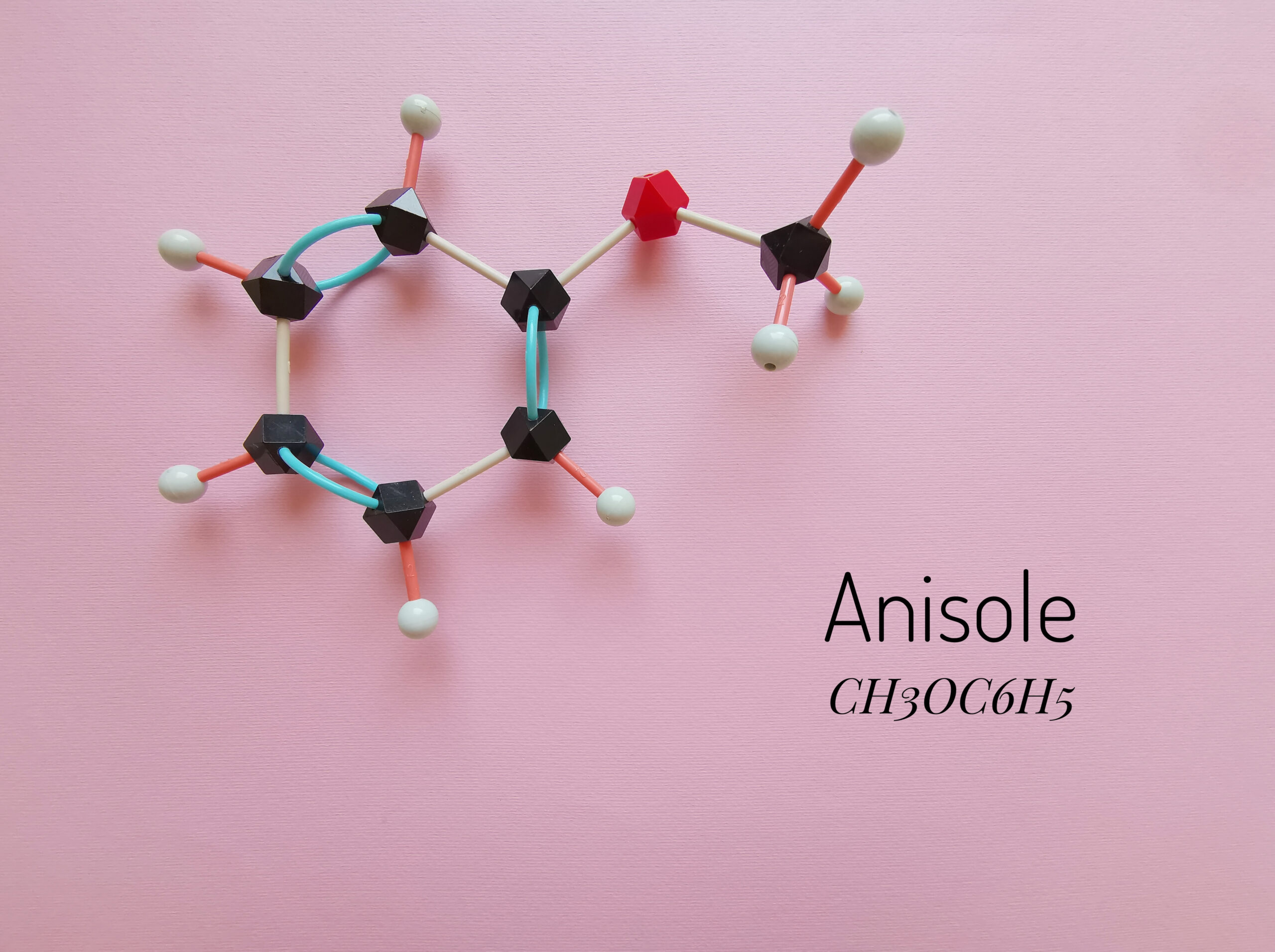INTRODUCTION
The aromatic is a liquid with a pleasant odor. The active methoxy group attached to a benzene ring renders a high amount of reactivity to the molecule. Worldwide, anisole is commercially produced by methylation of phenol.
| Synonyms | Methoxybenzene Phenyl Methyl Ether Methyl Phenyl Ether |
| CAS no. | 100-66-3 |
| EINECS no. | 202-876-1 |
| Molecular formula | C7H8O |
| Molecular weight | 108.14 |
| Structure |  |
APPLICATIONS
Anisole is used in various industry verticals including but not limited to manufacture of API, colorants, cosmetics, flavor & fragrance chemicals, polymerization inhibitors, antioxidants, and agrochemicals. It is also consumed as solvent in various chemicals processes.
| Pharmaceuticals | The sweet aromatic is a key starting compound in the manufacture of Tamoxifen, Guaifenesin, Carvedilol, Ranolazine and Methocarbamol. In the process, anisole is first converted into Guaiacol, which is an antioxidant. Guaiacol is then used to synthesize some of the above APIs. |
| Agrochemicals | The methoxylated benzene acts as an insect pheromone and it also finds usage in manufacture of Ancymidole (a plant growth regulator) and Methoxychlor (an insecticide). |
| Flavors, Fragrances, and Cosmetics | The aromatic compound is extensively employed, thanks to its odor, for production of F&F chemicals such as Anethole, p-anisaldehyde, Guaiacol, 4-methoxyacetophenone, etc. From the last compound, cosmetic ingredient Avobenzone is manufactured. |
| Inhibitor | A feeble but important use of anisole is in production of methyl ether of hydroquinone (MEHQ), which is one of the universal polymerization inhibitors. |
| Colorant | Anisole is a KRM in the manufacture of the dye Disperse Blue 73 from Acid Blue 45. |
SPECIFICATIONS
| Test | Unit | Specification |
|---|---|---|
| Appearance | – | Clear colorless liquid |
| Purity by GC | % | NLT 99.5 |
| Phenol Content by GC | ppm | NMT 50 |
| KF Moisture | % | NMT 0.1 |
| Iron | ppm | NMT 5 |
REACH status
Anisole offered by ExSyn is registered as Transported Isolated Intermediate (TII) under the EU REACH regulation.
STORAGE
Product is stored at ambient temperature.
PACKING
The product is offered in drum packing as well as ISO-tanks.
ExSyn offers this compound on commercial scale and welcomes enquiries. No matter the quantity you need, our exceptional quality and service will make ExSyn your supplier of choice ! If you need any additional information or SDS, please get in touch with us.
Phosphatidylcholine (PC) is one of the most important phospholipids derived from soya lecithin and represents a key structural component of cell membranes. Phosphatidylcholine 90% refers to a highly purified grade where the PC content is enriched to around 90% through specialized extraction and purification steps.
Indorez® Kota Resin is a modified non self-cured phenolic resin, it can increase rubber adhesion to steel, polyester, rayon, nylon, aramid and other fabric cord. It’s an adhesive agent, acts as methylene acceptor, can 100% replace resorcinol and resorcinol resins in resorcinol- formaldehyde-silica, enhance adhesion between rubber and reinforcing materials.
Glyceryl Stearate Citrate (GSC) is a plant-derived, biodegradable emulsifier commonly used in cosmetics and personal-care products. It functions primarily as an anionic oil-in-water (O/W) emulsifier, helping blend oils and water into smooth, stable creams and lotions. Its natural origin and gentle profile make it popular in eco-certified, organic, and sensitive-skin formulations.
DL-Serine is a racemic mixture of both the D- and L-forms of the amino acid serine, which is a polar, nonessential amino acid. It is an α-amino acid characterized by its hydroxyl-containing side chain, which enables it to take part in numerous biochemical reactions and synthetic processes. It functions as a pivotal intermediate in the biosynthesis of amino acids, including glycine and cysteine, underscoring its essential role in cellular metabolism. Moreover, it constitutes a critical pharmaceutical intermediate for the synthesis of a broad spectrum of therapeutic agents and drug candidates.
Ethyl vinyl ether is a reactive, flammable, volatile liquid with a strong ether-like odor. Featuring two conjugated functional groups—an ether and an alkene—this molecule act as important building block, especially in polymer synthesis. Its applications span multiple industrial sectors, including semiconductors, coatings, inks, fragrances, adhesives, paints, oil viscosity modifiers and pharmaceuticals, with promising potential as a dietary supplement.
Peppermint (Mentha piperita) is a common herb, also known as a hybrid mint. Its main components are oxygenated monoterpenes: alcohols, esters and ketones. Peppermint oleoresin microencapsulated powder is a white to off-white coloured powder produced from the seeds of the plant. In order to protect and maintain the stability of peppermint oil, microencapsulation is carried out through process optimization using the coacervation technique. This technique helps limit the loss and degradation of flavours and aromas during processing and storage. It offers versatile applications across multiple industries — from food and beverages to pharmaceuticals, cosmetics, and textiles.
5-Methyl-3-vinyl-2-oxazolidinone (V-MOX) is a highly reactive monomer valued for its low viscosity, mild odor, and excellent reactivity. It is widely used as a reactive diluent in UV-curable inks and coatings, where it enhances adhesion, produces brighter colors, and improves safety compared to conventional diluents. In addition, V-MOX serves as a key building block in the synthesis of kinetic hydrate inhibitor (KHI) polymers, which are applied in oil and gas production to prevent hydrate blockages in pipelines.
Zinc ricinoleate is the zinc salt of ricinoleic acid, a hydroxylated fatty acid derived mainly from castor oil (Ricinus communis). It appears as a white to slightly yellowish powder, waxy solid, or paste, depending on formulation. Its most valuable property is its ability to trap and absorb odor molecules such as amines, sulfides, and short-chain fatty acids, making it an essential ingredient in deodorant and odor-control products.
2-(tert-Butyl amino)ethyl methacrylate (TBAEMA) is a functional methacrylate monomer that contains a secondary amine group and a hydrophobic tert-butyl moiety, giving it excellent versatility in pH-responsive and adhesion-enhancing polymer systems.
It is valued in printing ink formulations for its ability to enhance adhesion, flexibility, and surface interaction.
